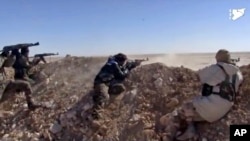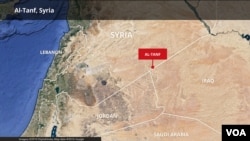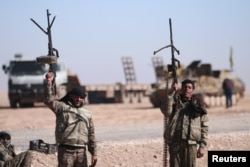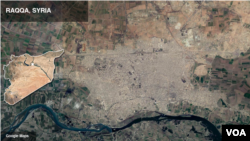A U.S. military aircraft shot down an armed, pro-Syrian government drone Thursday after it fired upon U.S.-led coalition members on patrol in southern Syria, a spokesman for the U.S.-led coalition said.
The incident was the first time that pro-regime forces attempted to strike coalition forces in the area surrounding al-Tanf, an army base where members of the coalition are training Syrians to fight Islamic State, U.S. Army Colonel Ryan Dillon told reporters at the Pentagon by video call from Baghdad.
Local counter-Islamic State fighters were patrolling with coalition troops about 60 kilometers east of al-Tanf base when the drone, similar in size to an MQ-1 Predator, launched a munition that failed to detonate, multiple officials told VOA.
"It hit dirt; it didn't hit any coalition forces," Dillon said, adding that the munition caused no casualties and no damage to equipment, but was "clearly meant as an attack."
Another U.S. military official told VOA that American troops were part of the targeted patrol.
About 40 pro-regime forces have set up camp overlooking a major road northwest of al-Tanf, in an area inside an established deconfliction zone that reaches about 55 kilometers around the base, according to officials. A larger contingency of pro-regime forces is patrolling northwest of the base outside of the established deconfliction zone.
"Our patrols were in the opposite direction of where the regime forces were," Dillon said.
Earlier in the day, the U.S.-led coalition said it also destroyed two pro-regime armed technical vehicles — essentially trucks with guns attached — that were advancing toward coalition forces within the deconfliction zone.
The coalition has said its mission is to defeat Islamic State forces in Iraq and Syria, but its forces always reserve the right to defend themselves against any threat.
A statement from U.S. Central Command, which oversees U.S. military operations in the Middle East, stressed that "the coalition does not seek to fight the Syrian regime, Russian or pro-regime forces partnered with them."
Thursday marks the third time coalition forces have struck pro-Syrian government forces in less than one month, forces that Defense Secretary Jim Mattis has said are believed to be "Iranian directed."
In all three instances — May 18, Tuesday and Thursday — the coalition targeted armed vehicles, tanks and construction vehicles that could be used to establish defensive positions. None of the strikes so far has targeted the pro-regime forces who are stationed along a major road inside the deconfliction zone, but coalition forces continue to urge those forces to leave.
"They have not presented a threat. They have not continued to move toward our forces in al-Tanf garrison, but we will continue to attempt to get them to vacate the area," Dillon said.
Michael O'Hanlon, a senior defense fellow at the Brookings Institution, told VOA on Thursday that the U.S. and Iran are now in "direct competition for certain access points inside eastern Syria."
"We don't necessarily want that for ourselves, but we don't want it for Iran," O'Hanlon said.
He said the U.S.-led coalition doesn't feel the need to concede territory there due to the lack of Iranian constituencies in the Sunni-majority area and the need to continue developing assets there to defeat Islamic State.
Meanwhile, Iranians sense an opportunity from the instability in Syria to create a continuous land bridge from Iran to the Mediterranean, according to O'Hanlon.
Raqqa
The attempted pro-regime drone attack comes as Syrian Democratic Forces entered their third day on the operation to defeat Islamic State forces in the terror group's de-facto capital, Raqqa.
Dillon told reporters the SDF already have a "foothold into the eastern part of Raqqa city center."
"Our forces are making swift advances," Zagros Qamishlo, a commander of SDF Kurdish element People's Protection Units, told VOA. She added that her team had pushed one kilometer into the eastern city limits.
U.S. officials estimate that there are about 2,500 Islamic State fighters inside the city and its suburbs. Those on the front lines say Islamic State militants are fighting back with a barrage of suicide car bombs and suicide fighters.
"A group of IS thugs tried to reverse our advances but coalition airplanes came to our support," Siwar Rozh, an SDF fighter, told VOA.
VOA footage of the scene shows thick smoke has covered the skyline over the city as SDF members are trying to push down into the IS neighborhoods.
A VOA reporter who visited areas captured by SDF Thursday said engineers have started clearing mines and booby traps to fully secure the buildings.
SDF commanders told VOA they have made arrangements to open safety corridors for civilians as they expect thousands to flee the fighting.
The International Rescue Committee estimates 200,000 people are trapped in the city and are at risk of being killed by IS if they attempt to flee or being used as human shields if they remain.
According to the anti-IS Raqqa is Being Slaughtered Silently group, civilians also face the risk of heavy coalition airstrikes as IS tries to hide among them. It said IS has confiscated most civilian houses that contain shelter spaces or basements.
Mahmoud Bali contributed to this story from Raqqa, Syria.











